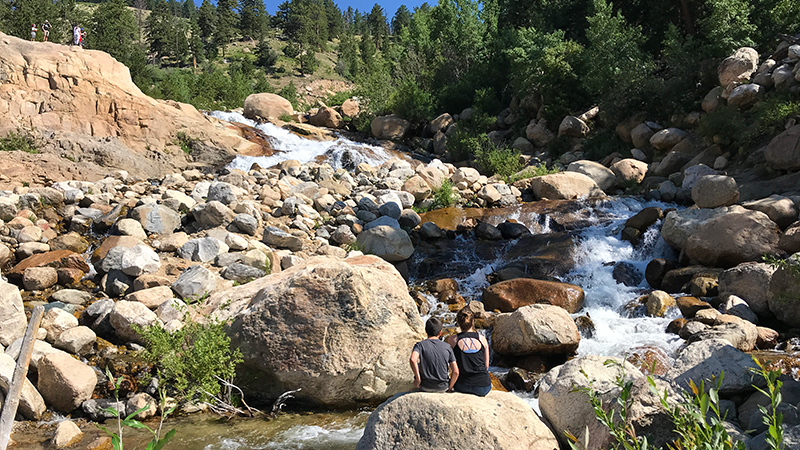
Our third day in Rocky Mountain National Park started off with a stop at the Fall River Visitor Center, hiking around the Alluvial Fan in Horseshoe Park, taking in the gorgeous scenic views from 3M Curve and the Longs Peak Viewpoint, and visiting the Moraine Park Discovery Center.
I had heard that we should visit the Alluvial Fan before we left on our summer road trip, and we saw lots of people climbing around the giant pile of rocks as we traveled Old Fall River Road — that had Carter itching to leap out of the truck. But wow, we weren’t prepared for how awesome it would be!
Alluvial Fan is the perfect stop for a picnic lunch and a fantastic stop for families with kids who love to climb rocks and need to burn off some boundless energy. The cool water cascading down the rocks also makes it a great place to pull up a rock and relax.
The 42 acre Alluvial Fan was created in July 1982 when Lawn Lake broke through its terminal moraine and sent 300 million gallons of water surging down the Roaring River, forming waterwalls up to 30 feet high.
The flood carried trees, car-sized boulders weighing up to 450 tons, lighter rocks, gravel, sand, and other debris to the valley floor where it spread out and slowed down, leaving behind a large alluvial fan that measures 44 feet deep in some places. The powerful flood waters continued down Fall River and hit the Cascade Dam, which failed and added more water to the flood. It then flowed to the town of Estes Park, Colorado, flooding it with six feet of mud and water.
A trash collector heard the waters crashing down the Roaring River and called park rangers who were able to evacuate campers at Aspenglen campgrounds before it was destroyed. Unfortunately, the flood killed three people camping in the park and caused $31 million in damage to the town of Estes Park and other downstream areas.
Visiting The Alluvial Fan Waterfall
There are two ways to access and explore Rocky Mountain National Park’s Alluvial Fan and waterfall off Old Fall River Road:
- East Parking Area:
A small parking area with access to the Alluvial Fan Trailhead. Alluvial Fan Trail is an easy, 0.3 mile, out and back trail that totals 0.6 miles. The beautiful walk travels right to the base of the waterfall. - West Parking Area:
A larger parking area with a vault restroom and picnic tables. From the parking area, you can follow the stream up to the side of the Alluvial Fan waterfall and get to higher viewpoints.
We parked in the East Parking Area and hiked in. Once the shady trail opened up on the Alluvial Fan, the kids took off, climbing over the field of boulders, exploring the waterfall, and seeing how cold the water is. Carter was in total heaven.
We snapped photos, relaxed in the sun, climbed on rocks, and marveled at the beauty that surrounded us. It was pretty incredible.
Know Before You Go
- The famous Alluvial Fan at Rocky Mountain National Park was created in 1982 when 29 million gallons of water washed down the Roaring River and flooded the town of Estes Park with 6 feet of mud and water.
- Today at the Alluvial Fan, you’ll find a mountain of boulders that were pushed down the river and a stunning waterfall cascading down it.
- The Alluvial Fan is located on Old Fall River Road, about 3.0 miles west of the Fall River Entrance Station in Estes Park, Colorado 80517, Larimer County.
- When traveling on Old Fall River Road, there are two access point for the Alluvial Fan: The first is the small East Parking Area before the Alluvial Fan, and the second is the larger West Parking Area on the other wide of the Alluvial Fan that has vault restrooms and picnic tables.
- The 0.3 mile out and back Alluvial Fan Trail (totaling 0.6 miles) leaves from the East Parking Area and provides amazing views from the bottom of the cascading waterfall.
- Access from the West Parking Area also provides waterfall access. While the view of the waterfall isn’t as impressive, access from this side does allow you to climb higher up the rocks toward the top of the waterfall and kids will find more boulders to climb on.
- Neither access point is accessible due to trail damage.
- Download the Fall River Area Trail Guide.









